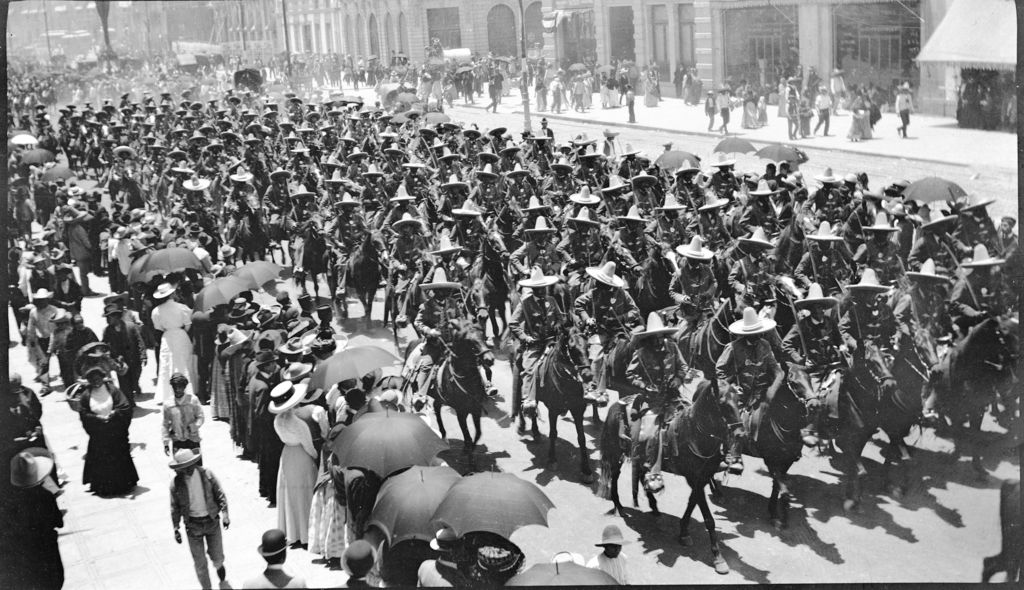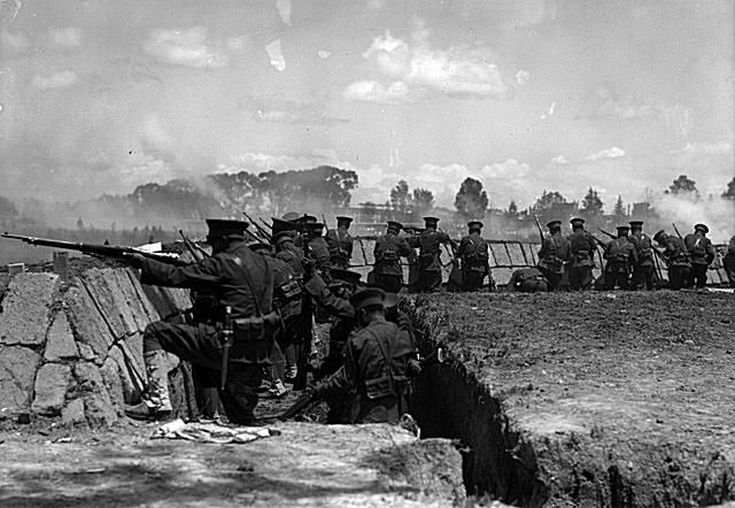 |
| Mexican Revolution |
In one of the most violent, chaotic, and consequential events in modern Latin American history, from 1910 to 1920 Mexico was convulsed in a massive social revolution and civil war. The first major social revolution in postcolonial Latin America, the Mexican Revolution arose from complex origins and bequeathed an equally complex legacy.
The origins of the revolution can be traced to two major trends from the late 19th century, both set in motion under the dictatorship of Porfirio Díaz (the Porfiriato, 1876–1910) that transformed the country's economy and society in far-reaching ways.
Both trends resulted from rapid capitalist development combined with the oligarchic nature of Porfirian politics. These two trends gave the revolution its dual character as both a middle-class revolt and a mass popular uprising.
  |
The first trend was the process by which capitalist development fostered the formation of an emergent middle and professional class that was systematically shut out of the nation's political life by the Porfirian oligarchy.
Thus, the revolution began in 1910 as a middleclass revolt against the corrupt Díaz dictatorship, led by the wealthy landowner Francisco Madero under the slogan "no reelection." In essence, this emergent middle and professional class, represented by Madero and other reformers, sought a greater political voice and an opening up of the political system, in keeping with classical liberal democratic principles.
The second trend had its roots in the countryside, where the great majority of Mexicans (around 90 percent) resided. This was the process of land concentration and related forms of rural oppression, which resulted in growing landlessness, poverty, hunger, and destitution among the rural majority.
Thus, when Madero launched his revolt against Díaz in 1910, it opened up an opportunity for the rural poor to press their claims and vent their accumulated grievances, principally the return of the lands that had been taken from them in the previous decades and the exaction of retribution against abusive local powerholders. These were the origins of the revolution's popular, agrarian impulse, epitomized in the figure of Emiliano Zapata and his slogan "Land and Liberty."
 |
| Mexican soldiers |
These twin engines of revolution—a middleand professional-class reformist impulse and a lower-class, agrarian, social-revolutionary impulse—combined to make the Mexican Revolution both a political revolt from above and a social revolution from below. The complex sequence of events from 1910 to 1920 reflects these dual and often contradictory impulses.
The most important of these events can only be summarized in capsule form here. The rigged elections of June 21, 1910, swept the 79-year-old Porfirio Díaz into his final term in office. On October 5 in San Antonio, Texas, Francisco Madero, recently released from jail, proclaimed himself in revolt against Díaz in his Plan of San Luis Potosí, a reformist document calling for a return to the principles of the 1857 constitution.
In May 1911 the combined forces of Madero, Pascual Orozco, and Pancho Villa defeated Díaz's federal troops in the border city of Ciudad Juárez. In accord with the provisions of the Treaty of Ciudad Juárez, Díaz resigned; his foreign secretary, Francisco León de la Barra, became interim president (May–November 1911).
   |
On October 1, 1911, Madero was elected president. He served for 15 months (November 1911–February 1913). His presidency was largely a failure, his moderate reforms placating neither hardline Porfiristas nor agrarian radicals like Zapata and Orozco.
On February 18, 1913, Madero was overthrown by one of his leading generals, the conservative Victoriano Huerta, following the the Decena Trágica (Tragic Ten Days), a destructive battle in Mexico City between Porfiristas and Maderistas—an overthrow made possible by the "Pact of the Embassy" between Huerta and U.S. ambassador Henry Lane Wilson.
Huerta, reputed for his cruelty and hard drinking, ruled for the next 17 months (February 1913–July 1914). His regime, whose policies garnered the animosity of the United States, was overthrown by the constitutionalists under Venustiano Carranza following the U.S. occupation of the port city of Veracruz, which had begun on April 21, 1914.
The three years following Huerta's ouster were the most chaotic of the revolution, with several major and scores of minor armies wreaking havoc across the country. The most prominent figures included Pancho Villa and Pascual Orozco in the north; Zapata in the south; and the constitutionalists Carranza, Plutarco Calles, and Alvaro Obregón. In December 1914 Villa and Zapata briefly occupied Mexico City.
Five months later—in April 1915—came the most famous military engagement of the war: the Battles of Celaya (in the state of Querétaro, April 6–7 and 13–15), in which Villa's cavalry, estimated at more than 25,000 strong, was nearly destroyed by Obregón's entrenched forces (Obregón was a keen student of European trench warfare). The battles' outcome heralded the rising fortunes of Carranza and the constitutionalists. Villa, his army severely weakend, retreated northward.
After the United States recognized Carranza as Mexico's legitimate head of state in October 1915, Villa staged a series of anti-U.S. reprisals, most famously his raid of Columbus, New Mexico, on March 9, 1916, in which his forces killed 18 U.S. citizens and looted and burned the town.
The United States responded with Pershing's Punitive Expedition, in which General John J. Pershing led some 6,000 U.S. troops into the northern Mexican deserts in pursuit of Villa. The expedition, which cost $130 million, failed and withdrew from Mexico in January 1917. Meanwhile, in the south the Zapatistas continued their guerrilla campaign against the Carranza government, which had not endorsed Zapata's Plan of Ayala demanding agrarian reform.
In November 1916 Carranza and the constitutionalists, entrenched in Mexico City, convened a constitutional convention in the city of Querétaro. Excluding Villistas, Zapatistas, Huertistas, and others, the meetings eventually produced the constitution of 1917, which governs Mexico to the present day. In March 1917 Carranza was elected president of Mexico, an office he assumed on May 1.
Several months earlier, in January 1917, Carranza had been approached by the German ambassador with a proposal to ally with Germany in a war against the United States (following his instructions in the famous Zimmermann Telegram, sent January 16, 1917, by the German foreign secretary Arthur Zimmermann). Carranza refused the offer, but the telegram, intercepted by the British, is often cited as hastening U.S. entry into World War I.
With the formation of a constitutional, U.S.recognized government in Mexico City, the most violent years of the revolution were drawing to a close. While fighting still raged across much of the country, by this time many Mexicans had wearied of the violence.
In the south the Zaptistas put up a stiff resistance against Carrancista forces sent down to suppress their armies. In early 1919 Carranza dispatched a hit squad to Morelos to assassinate Zapata, which it did on April 10. A year later, on May 21, 1920, Carranza himself fell to an assassin's bullet, leaving the presidency open to Obregón, one of whose allies had pulled the trigger.
When the revolution began in 1910, Mexico was home to an estimated 15 million people; 10 years later that number had dropped to an estimated 14 million. In other words, between 1 and 2 million Mexicans died during this "age of violence," while an additional quarter million or more migrated north to the United States—marking the origins of many Mexican-American communities in major U.S. cities like Detroit, Chicago, and others.
After 1917 the revolutionary regime, dominated by elites from the northern state of Sonora (especially Obregón, Calles, and Adolfo de la Huerta), entrenched itself in power. Through the 1920s the revolutionary state became increasingly institutionalized and its policies increasingly conservative.
It retained power despite frequent flare-ups of violence, most notably the Cristero Revolt of 1926–29, sparked by the Catholic Church's disgruntlement with the constitution's anticlerical provisions, in which an estimated 80,000 people died.
The revolution bequeathed a complex legacy, not only in Mexico but across the hemisphere. Radicalizing an entire generation of politicians, intellectuals, labor leaders, and activists, it also helped to create a new narrative of Mexican history that put Indians and mestizos at the center of the nation's past (as seen most graphically in the public murals of Diego Rivera), while contributing to the erosion of traditional bonds of deference and relations of domination-subordination that had been so central to the country's postconquest history. It also largely failed to deliver on the promise of agrarian reform, at least in the short term.
Of the revolution's twin engines of a politically disenfranchised rising middle class and an impoverished agrarian sector, the former essentially triumphed—expressed most concretely in the dominance of the Sonorans and the formation in 1929 of the predecessor to the PRI (Institutional Revolutionary Party), a political party that was (and remains) "revolutionary" in name only, that dominated the country's politics in a "one-party democracy" for most of the 20th century. It was not until the presidency of Lázaro Cárdenas (1934–40) that popular demands for agrarian reform were largely met.